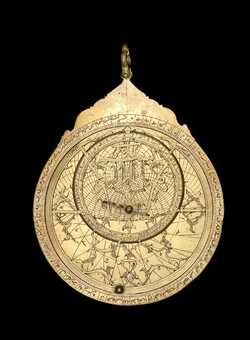| Date | 1682 (A.H. 1093) |
| Maker | Qāsim ‘Alī Qā’inī |
| Place | Persia |
| Material | Brass |
| Inventory no. | 45509 |
| Acquisition | Presented by J. A. Billmeir in 1957 |
The rete on this instrument is particularly decorative. The star pointer for Vega is a sitting bird. It was not uncommon for Islamic instruments to use a bird to point to Vega. Indeed, the Arabic name نسر الواقع (Nasr al-Waqi‘) means falling eagle. Although the name means falling eagle, the bird is usually depicted upright, perched or sitting, as in this case.
More unusual, at least in the Museum's collection, is the fact that the rete also incorporates the invocation from the Qur’an into the strapwork of the rete within the ecliptic. The invocation reads: بسم الله الرحمن الرحيم (commonly translated as 'In the name of Allah, the Beneficent, the Merciful'). On the rete, the words of the invocation are rearranged to fit the physical needs of the rete's shape. The word الله (Allah) is at the top; بسم (bi-smi) is immediately below it. Then Allah's two traits, الرحمن and الرحيم are arranged symmetrically on either side of the bird. One other astrolabe in the collection (inventory no. 37148) originally incorporated an inscription into the rete, but most of this has now been lost.
View all
images for this astrolabe
View
detailed provenance for this astrolabe
Mater
The mater and limb are of one-piece construction. The tab on the inside of this limb, used to hold the tympans in place, is set about 2° too far to the right. Consequently, the tympans are rotated about 2° from the meridian. Scales on the limb: degree scale. More informationBack
The back contains 15 scales of the following types: Altitude; Sine/Cosine; Declination; Azimuth of Qibla; Shadow square; Cotangent; Triplicities; Zodiacal signs; Lunar Mansions; Faces; Decans. The back is inscribed: with a maker's signature marked as صنعت قاسم على قائني ١٠٩٣ (Qāsim ‘Alī Qā’inī made this, A.H. 1093). with a marked as [inscription in upper right quadrant, just above the central hole]. [ pending ]. More informationRete, Pin & Wedge
The rete contains 38 stars. The rete contains zoomorphs: vega is shaped like a bird The zodiac on the rete is labelled: الحمل , الثور , الجوزا , السرطان , الاسد , السنبله , الميزان , العقرب , القوس , الجدي , الدلو , الحوت .The rete is inscribed with a qur'anic verse marked as: بسم الله الرحمن الرحيم (In the name of Allah, the Beneficent, the Merciful). This inscription is incorporated into the tracery itself.The rete contains 1 scale of the following type: Ecliptic.
The rete is attached using a pin & wedge. More information
Rules & Alidades
| Type | Details |
|---|---|
| Alidade | Double-ended. This alidade was repaired at the right
sighting vane. |



